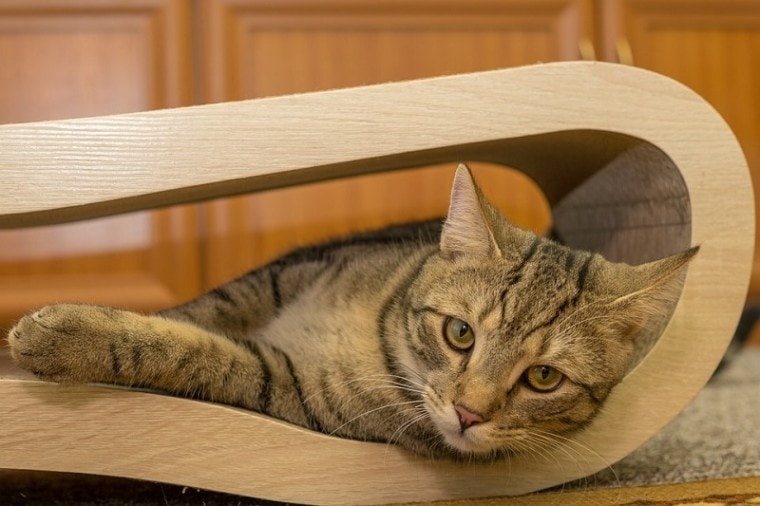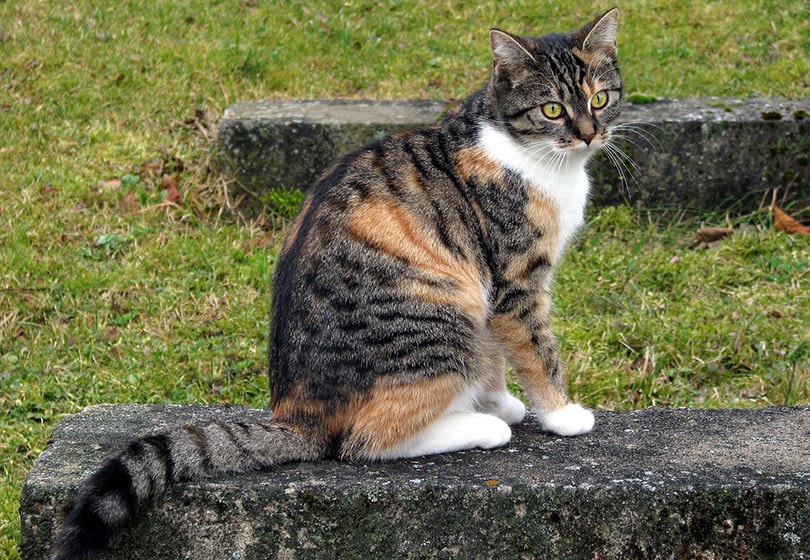
Click Below to Skip Ahead
The blue-blooded relative of the common European house cat, the European shorthair is one of the oldest and most popular European cat breeds. They originated in Sweden but are descended from ancient Roman barn cats that befriended Roman soldiers.
Loyal and loving, they are affectionate and playful with their families but territorial and shy around strangers. With a medium-sized, muscular build, they love to hunt and stay active. They have round faces with striking eyes, a soft belly that can get a bit of a pooch, and they come in a variety of colors.
Breed Overview
Height:
9–11 inches
Weight:
12–15 pounds
Lifespan:
15–20 years
Colors:
Brown, sable, cinnamon, lavender, silver, fawn, blue, gray, black, cream, beige, white, tan, lilac, red, orange
Suitable for:
First-time pet owners, families with kids and dogs
Temperament:
Social and affectionate, easy to train, territorial, good hunter, loyal, can be alone but enjoys attention, shy with strangers
Because they have a broad genetic background, European Shorthair cats can have varying personalities and temperaments, but their generally adaptable, friendly nature makes them an ideal choice for families and new pet owners.
Read on to learn more about why these fun-loving, beautiful cats could make such a great addition to your home and your lap.
European Shorthair Cat Characteristics
European Shorthair Kittens

If you’re on the hunt for your own furry ball of joy, you shouldn’t have to spend an exorbitant amount—even though this cat breed is rare outside of Europe. You may get lucky and find one at your local shelter. In that case, they would have already been examined, vaccinated, and spayed or neutered for you.
When you welcome a European Shorthair kitten into your home, be ready to have a loyal cat by your side. They enjoy human company but they can also be quite independent. These cats are easy to care for, making them a great choice for first-time cat owners. Keep reading the European Shorthair’s full care guide to know what type of diet, exercise, and grooming they need!
Temperament & Intelligence of the European Shorthair
The European Shorthair cat is known for its versatility and ability to fit into a variety of living environments, making them ideal for families, singles, apartments, and farms. Nowhere is their high intelligence more evident than in their ability to make the most of their living situation.
Personalities can vary between cats from outgoing and personable to shy and reserved. Some love to play and socialize, and some take longer to warm up to their family. But even if it takes a bit more time, many European Shorthair cats develop deep, lasting bonds with their owners.
They are the ideal outdoor/indoor cat due to their explorative nature and love of the outdoors. Because they are descended from barn cats, they are naturally comfortable having the freedom to go out and hunt. Since this can be dangerous for house cats, many owners set up a perch near a window so their cats can enjoy watching what’s happening outside.
Even if yours is strictly an indoor cat, be careful not to leave the house door open because they will most likely venture through to see what’s on the other side.

Are These Cats Good for Families? 👪
Yes! With its adaptability and social nature, the European Shorthair is an ideal cat for families. They get along with people of all ages and don’t get upset by changes in their environment. If you’re looking for a cat that will enjoy snuggling in your lap as well as time by themself, then the European Shorthair is the one to get.
If you have young children, they must know how to treat a cat. If they are calm and treat the cat gently, the cat will most likely bond and be as loyal to them as to the adults. If a child treats them roughly, they’ll distance themselves and keep away.
A family can also be ideal for a European Shorthair because of the multiple people to interact and play with. Beyond the physical activity, the different relationships would stimulate their intelligence and keep them interested in what goes on in the home.
Does This Breed Get Along with Other Pets?
One of the most appealing qualities of the European Shorthair is their adaptable nature when it comes to other pets in their home.
They can get along well with dogs and other cats, especially if those other animals aren’t aggressive. However, their territorial nature could become an issue if they decide they don’t like a new addition. Of course, no two cats are the same, so it’s wise to practice socialization with kittens and watch your older cat carefully to see if they’re comfortable with the situation.
If you have small rodent pets like hamsters and gerbils, they are more likely to be candidates for the next meal than a new friend! The European Shorthair’s finely tuned predatory instincts will not bode well for other small, furry inhabitants.
Things to Know When Owning a European Shorthair:
You won’t have to worry about buying expensive cat food or putting a lot of time into grooming your European Shorthair. Their low-maintenance lifestyle and playful nature make them easy pets to enjoy.
Below is all the important info you need to know to keep your kitty happy.
Food & Diet Requirements 
Rather than shelling out big bucks for the fanciest cat food on the market, quality dry food is perfectly adequate. Be sure to get one with good ingredients and plenty of protein to support your cat’s energy levels and keep them at a healthy weight.

Exercise 🐈
The European Shorthair is naturally active and curious. Working in some daily play time will help keep them happy and healthy. Fortunately, they take care of themselves most of the time, so you don’t have to devote half your day to keep them busy. A simple play session once or twice a day should do the trick.
Puzzle toys are great for mental stimulation and challenging their intelligence. Toy mice and laser pointers are ideal for satisfying their urge to hunt and will help keep them trim if their belly looks too round!
Since every cat has its own preferences, try experimenting with different toys to see which they like best. Keeping a variety in the home will ensure your cat won’t get bored.
Training 🧶
Because of their intelligence, European Shorthair cats are generally easy to train. Their love of exploration comes in handy when it comes time to teach them something new. Using treats and praise will provide the positive reinforcement needed for them to happily develop good manners.

Grooming ✂️
Known for their low maintenance, the European Shorthair cat has a short fur coat that can easily be brushed once a week to keep it smooth and shiny. They love to clean themselves, so they rarely need baths. Besides the occasional brushing, you may also need to trim their claws and clean their ears.
Health and Conditions 🏥
The European Shorthair is generally a very healthy, long-lived breed. Due to their mixed ancestry, there aren’t any breed-specific diseases, but there are a few conditions they seem to be more susceptible to that are listed below.
But don’t panic—this doesn’t mean that your cat is destined to have one.
As always, keep a watchful eye on your furry friend to notice any changes of behavior or signs of pain. Take them into the vet for regular checkups, feed them quality food, and you will most likely be able to enjoy their company for years to come.
3 Little-Known Facts About the European Shorthair Cat
1. They are descended from ancient Roman barn cats
Even though the modern breed originated in Sweden, their lineage can be traced back to the barn cats of Rome who befriended the Roman soldiers. They kept the barns free of mice and developed keen hunting abilities that they passed down to their descendants.
Through careful breeding, today’s European Shorthair still retains many of the physical characteristics of their ancient Roman ancestors.
2. They were formerly known as the Celtic Shorthair until 1982
The European Shorthair used to be a general name for all the common, short-haired domestic cats in Europe. This was confusing and caused many different breeds to be lumped into one category. The Celtic Shorthair was one such breed, even though they have different characteristics.
Eventually, these distinct differences were noted, and the breeds became separated. It’s only been since 1982 that the European Shorthair has been recognized as a specific breed. Now, only true European Shorthair cats can be registered as such.
3. They have a big appetite
Have you ever seen a cat turn up its nose at a dish of unsatisfactory cat food? No such problem with the European Shorthair. Being the descendant of barn cats with strong hunting instincts, they have no problem devouring whatever they can get.
While this makes feeding them a simple matter, it means they also tend to gain weight more quickly if there is always food available. Since every cat has different activity levels, it’s important to watch yours and see if they need more exercise or another type of food. If you have any serious concerns, you can always discuss their diet with your vet for recommendations.

Final Thoughts
The European Shorthair, with its long-standing popularity for being loyal, playful, and adaptable, can make a perfect addition to your home. Easy to feed and care for, they are ideal for first-time pet owners and families with children.
The European Shorthair carries on the hunting skills of their ancient predecessors and will make sure your home never has a mouse problem. Their energetic, explorative nature makes for easy training and fun companionship that you can enjoy for many years. Whether you’re an experienced cat owner or someone just considering the idea, the European Shorthair may be the ideal choice for you!
You Might Also Be Interested In:
- Cornish Rex Cat
- Oriental Shorthair Cat Breed
- Ragdoll
- 12 Best Cat Breeds for First-Time Cat Owners (With Pictures)
Featured Image Credit: guvo59, Pixabay







